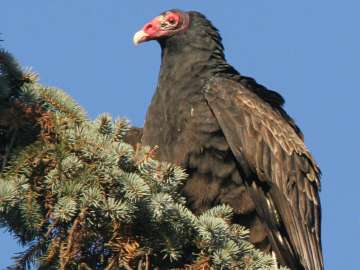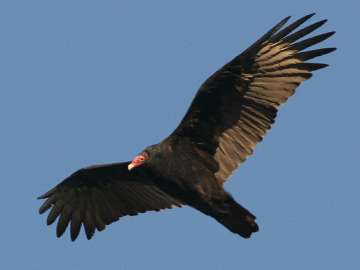

PHOTO COURTESY OF GARRY KESSLER
Turkey vultures may be unglamorous with their featherless red heads, hooked white beaks, and diet of carrion, but their return to Westborough is a sign of spring. They are considered beneficial. Males and females look similar, although females are slightly larger.
April 8, 2011, Page 4
NATURE NOTES
By Annie Reid
Westborough Community Land Trust
Airborne clean-up crew returns
They’re back – the turkey vultures, nature’s airborne clean-up crew, are soaring over Westborough again.
Turkey vultures (Cathartes aura) are raptors – birds of prey – but they aren’t killers. Their prey is already dead. They specialize in eating decaying meat, or carrion. They’re with us for most of the year, ridding the environment of tons of carrion. Because they’re not good at eating frozen meat, they usually depart in November and return in late February.
You’re most likely to see a turkey vulture at a distance. You might notice one – or more – gliding low over the treetops, searching by scent and sight for road kill and other carrion. Look for them along roads, highways, and edges of fields and ponds.
But is this clean-up crew a bit tipsy? To look at turkey vultures in flight, you might think so. They hold their wings in a shallow “V” and seem to wobble in the air, rocking unevenly from side to side as they fly.
Does this wobbly flight mean they’re awkward when flying? On the contrary, turkey vultures are very efficient flyers. They spend many hours in the air as they search for food, but they flap their wings only occasionally. Mostly they ride the currents in the air.
So what is the tipsy flight all about? It helps them catch low-level air currents and maneuver to pick up the scent of carrion.
You can recognize turkey vultures in the air by the shallow “V” that their wings make and by their tipsy flight. In contrast, other raptors that we also see flying above the treetops, such as red-tailed hawks (Buteo jamaicensis), have a steady-looking flight. They hold their wings out straight and don’t wobble.
Afternoon is usually best for catching sight of turkey vultures. These big birds tend to get a slow start in the morning. They usually wait for air currents to develop in the afternoon as the earth and air heat unevenly throughout the day. So if you’re not a morning person, perhaps you’ll appreciate these “afternoon birds.”
In the mornings, turkey vultures may perch in sunny spots in the trees – especially evergreens and dead trees – and spread their wings to soak up the sun’s warmth. (If you notice medium-sized dark birds doing this on the dead trees in Mill Pond, you’re probably looking at cormorants drying their wings, not turkey vultures.)
Turkey vultures have an exceptional sense of smell, unlike other raptors. Scent is one of the ways these scavengers locate carrion. Sight is the other way, but turkey vultures can find carcasses that are hidden from view on the forest floor. Not surprisingly, the part of their brain that handles scent, called the olfactory bulb, is larger and better developed than it is in almost all other birds.
One scent that attracts turkey vultures is a chemical found in rotting meat called ethyl mercaptan. When researchers release a little of this chemical into the air, turkey vultures show up from miles around. When it is added to gas pipelines, engineers discover leaks by noting where turkey vultures circle. Interestingly, turkey vultures are also attracted to certain mushrooms and wildflowers that give off an odor of carrion.

PHOTO COURTESY OF GARRY KESSLER
Turkey vultures soar overhead thanks to long wings that are large in relation to their body weight. They have a 5 and a half-foot wingspan and 4 and a half- pound body. The slots between the feathers at their wingtips help them control their speed, position in the air, and the lift that their wings provide. In the air, a turkey vulture’s head looks small.
Turkey vultures are well equipped for eating decaying meat. As part of nature’s clean-up crew, they are able to eat decaying meat without becoming ill or spreading disease. Their digestive system destroys bacteria and toxins that come with their meal. They are vulnerable to lead poisoning, however, from lead shot in the meat they eat.
We don’t often get to see turkey vultures up close, but they have a naked head, without feathers. It’s suited for plunging into a corpse without the muss and fuss of cleaning feathers afterward. In the air, a turkey vulture’s head simply looks small, but in a closer view it is bare-skinned and red. Like other raptors, turkey vultures have a hooked beak for tearing flesh.
But unlike other raptors such as hawks, turkey vultures do not have strong, sharp claws for gripping and killing prey. Instead, their feet are more suited for walking, which they do when they feed at a carcass. Their feet aren’t strong enough to carry away dead meat, so they tend to eat it where they find it.
In fact, turkey vultures’ feet are more like storks’ feet than like hawks’ feet. This similarity is one of several reasons why many scientists think that turkey vultures may be more closely related to storks than to hawks.
Turkey vultures also share with storks a certain way of cooling themselves off in hot weather: they squirt their liquid droppings on their feet and legs. As the liquid dries, it cools them and makes their legs look white. It’s not an attractive habit from our point of view, but apparently it’s effective.
Why are these scavengers called turkey vultures? Walking around on the ground, they look enough like wild turkeys that you might mistake them for turkeys. Their red, naked heads also bring turkeys to mind.
Turkey vultures are largely silent. They lack the voice box that other raptors have. All they can do is grunt and hiss. Turkey vulture chicks, cute and fuzzy with white down, are particularly good at hissing.
Turkey vultures are native to the Americas. They live year-round in the southern and southeastern U.S., as well as Mexico, Central America, and South America but summer as far north as southern Canada. They share much of their range with black vultures (Coragyps atratus), but these slightly smaller, more aggressive vultures rarely appear in Massachusetts.
In the past century, turkey vultures have been expanding their range northward. They’ve bred in Massachusetts since 1954. What brought about this expansion? It coincides with increased development, which led to many more roads and road kills, especially road-killed deer but also squirrels, skunks, and raccoons. More work for the clean-up crew!
Turkey vultures can withstand a certain amount of cold. Like our native black-capped chickadees, they can conserve energy on cold nights by allowing their body temperature to drop as much as 10 degrees F. Some winter as far north as Connecticut.
Male and female turkey vultures pair up long-term, perhaps for life or until one dies. They don’t build nests, but they lay their eggs on cliffs or in rocky crevices or hollow logs, far away from human activity. They typically raise two chicks. Both male and female incubate the eggs and feed the chicks.
Would you like to see live raptors and learn more about them? Don’t miss WCLT’s live animal program featuring Massachusetts birds of prey tomorrow, Saturday, April 9, at 10:00 AM at the Knights of Columbus Hall (17 Willow St.). Enjoy a rare close-up look at live hawks and an eagle, a peregrine falcon, a great horned owl, and a turkey vulture in this program by Tom Ricardi, a licensed rehabilitator and wildlife biologist. Learn about the work being done by the Massachusetts Bird of Prey Rehabilitation Facility, where Tom cares for injured birds and runs a successful captive-breeding program.